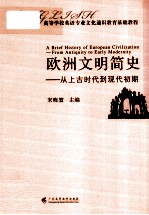图书介绍
欧洲文明简史 从上古时代到现代初期PDF|Epub|txt|kindle电子书版本网盘下载

- 宋晓堃主编;尚劝余,张华鸿,詹俊峰,梅园副主编 著
- 出版社: 广州:广东高等教育出版社
- ISBN:9787536141773
- 出版时间:2011
- 标注页数:349页
- 文件大小:108MB
- 文件页数:360页
- 主题词:英语-高等学校-教材;文化史-欧洲
PDF下载
下载说明
欧洲文明简史 从上古时代到现代初期PDF格式电子书版下载
下载的文件为RAR压缩包。需要使用解压软件进行解压得到PDF格式图书。建议使用BT下载工具Free Download Manager进行下载,简称FDM(免费,没有广告,支持多平台)。本站资源全部打包为BT种子。所以需要使用专业的BT下载软件进行下载。如BitComet qBittorrent uTorrent等BT下载工具。迅雷目前由于本站不是热门资源。不推荐使用!后期资源热门了。安装了迅雷也可以迅雷进行下载!
(文件页数 要大于 标注页数,上中下等多册电子书除外)
注意:本站所有压缩包均有解压码: 点击下载压缩包解压工具
图书目录
Part Ⅰ Ancient World4
Chapter 1 Civilizations in the Ancient Near East1.Introduction4
2.Civilization in Mesopotamia5
2.1 Brief history of Mesopotamia6
2.2 The Cultural Achievements of Mesopotamia11
3.Ancient Egyptian Civilization15
3.1 Egypt:"The Gift of the Nile"15
3.2 A Brief History of Ancient Egypt17
3.3 Ancient Egyptian Culture and Society18
4.The Hebrews:History and Religion24
4.1 "The Children of Israel":A Brief History25
4.2 Israelite Religion:Judaism27
5.Conclusion29
Exercises30
Chapter 2 Greek Civilization33
1.Introduction33
2.History of the Ancient Greeks34
2.1 Early Greece35
2.2 The Dark Age(1200—50 BC)38
2.3 The Archaic Period(750—500 BC)38
2.4 The Classical Period(500—338 BC)45
2.5 The Hellenistic Period(323—31 BC)51
3.Cultural Achievements of the Ancient Greeks54
3.1 Religion and Mythology55
3.2 Philosophy57
3.3 Science61
3.4 Literature62
3.5 Historiography66
3.6 Art68
4.Conclusion72
Exercises73
Chapter 3 Roman Civilization:from A City to An Empire1.Introduction77
2.Rome:from Republic to Empire78
2.1 The First Romans and Their Neighbors79
2.2 The Roman Republic(509—31 BC)81
2.3 Roman Expansion86
2.4 The Collapse of the Roman Republic(133—31 BC)90
2.5 The Early Empire(31 BC—180 AD)92
3.Roman Culture96
3.1 Government96
3.2 Evolution of Roman Law97
3.3 Roman Engineering and Architecture98
3.4 Literature100
3.5 Historiography103
3.6 Sculpture and Painting103
3.7 Science104
4.Conclusion105
Exercises108
Chapter 4 Decline of the Roman Empire and Rise of Christianity1.Introduction111
2.The Crisis of the Empire113
2.1 The Flawed Imperial Political System114
2.2 Crisis of the Slave Economy116
2.3 The Culture of Bread and the Circus119
3.The Empire Reorganized122
3.1 Dividing the Empire122
3.2 The Reign of Constantine(312—395)124
4.Transformation of the Roman World:the Development of Christianity125
4.1 Imperial Roman Religious Beliefs126
4.2 Jews under Roman Rule128
4.3 The Career of Jesus128
4.4 The Rise of Christianity132
4.5 The New Contours of Fourth-Century Christianity135
5.Transformation of the Roman World:the Germanic Invasion138
5.1 Early German-Roman Relationship138
5.2 The Rise of German Kingdoms and the Fall of the Western Roman Empire142
6.Conclusion145
Exercises147
Part Ⅱ The Medieval World153
Chapter 5 The Early Middle Ages(500—1000)153
1.Introduction153
2.The Byzantine Empire154
2.1 The Reign of Justinian(rule 527—565)155
2.2 Economy and Society in Byzantium158
2.3 Byzantine Culture160
2.4 What Made the Byzantine Empire Strong163
3.The Rise of Islam165
3.1 Arabia Before Muhammad166
3.2 The Founding of Islam167
3.3 The Religious Teachings of Islam168
3.4 Conquest of Islam169
3.5 Economy of the Islamic Empire171
3.6 Islamic Culture172
4.The Western Christian World175
4.1 The Rise of the Frankish Empire176
4.2 The Disintegration of the Carolingian Empire179
4.3 Early England180
4.4 Ninth-Century Invasions181
4.5 Economy and Society in the Early Middle Ages182
4.6 Culture in the Christian West185
5.Conclusion187
Exercises188
Chapter 6 The Central Middle Ages(1000—1300)192
1.Introduction192
2.Economic Takeoff and Social Change193
2.1 Agricultural Revolution and Rural Society194
2.2 The Rise of Trade and Towns198
3.The Church Triumphant204
3.1 The Centralized Structure of the Medieval Church205
3.2 Unifying the Church's Theological Doctrine208
3.3 Christian Conquests and the Crusades209
4.The Emergence and Growth of National Monarchies216
4.1 England217
4.2 Capetian France(987—1314)219
4.3 The Land of the Holy Roman Empire:Germany and Italy220
5.Intellectual Revival and Cultural Development225
5.1 Education and the Rise of Universities225
5.2 Philosophy and Theology227
5.3 Science228
5.4 Literature229
5.5 Art232
6.Conclusion235
Exercises236
Chapter 7 Crisis in Late Medieval Western Europe(1300—1500)1.Introduction241
2.Economic Crisis and Recovery242
2.1 Agricultural Failure and Great Famine243
2.2 The Black Death244
2.3 A New Economic Equilibrium Out of the Depression246
3.Social Crisis and Popular Unrest248
3.1 Revolts in the Rural Areas248
3.2 Revolts in the Cities250
4.Political Crisis and Recovery251
4.1 The Hundred Years'War251
4.2 Political Crisis and Recovery256
5.The Crisis of the Western Christian Church260
5.1 The Babylonian Captivity261
5.2 The Western Schism(1378—1417)263
5.3 Religious Protest264
6.Conclusion267
Exercises268
Part Ⅲ Transition from Middle Ages to Early Modern EraChapter 8 Renaissance(1350—1600)1.Introduction275
2.The States of Northern Italy277
2.1 Milan277
2.2 Venice278
2.3 Florence279
3.Italian Renaissance Culture280
3.1 Italian Renaissance:Humanism at a Glance281
3.2 Italian Intellectual Renaissance:Literature and Thought282
3.3 Italian Renaissance Art285
4.Northern Renaissance293
4.1 Northern Christian Humanism293
4.2 Northern Renaissance Literature296
4.3 Northern Renaissance Art299
5.Scientific Accomplishments301
6.Conclusion303
Exercises305
Chapter 9 Reformation(1500—1600)309
1.Introduction309
2.Religious and Social Background of the Reformation310
2.1 The Church of Rome Around 1500310
2.2 Corruption and Malpractices within the Church312
3.Luther and the German Reformation315
3.1 Martin Luther(1483—1546)315
3.2 Luther's Teachings316
3.3 The Reformation in Germany319
4.The Spread of the Protestant Reformation323
4.1 The Reformation in Switzerland324
4.2 The Reformation in England328
5.The Catholic Counter-Reformation332
5.1 The Council of Trent333
5.2 New Religious Orders:The Jesuits334
6.General Effects of the Reformation336
7.Conclusion337
Exercises338
参考文献343
Keys to Exercises348